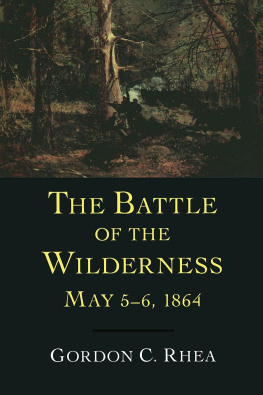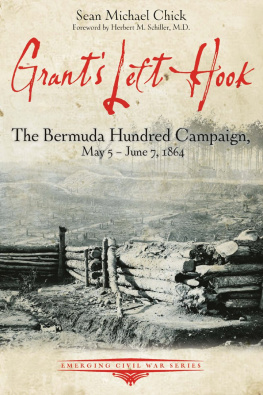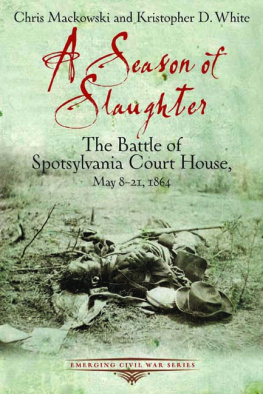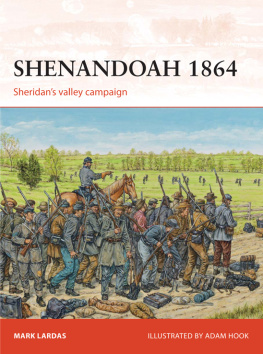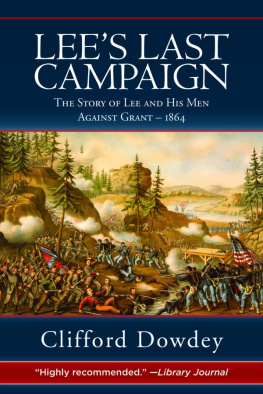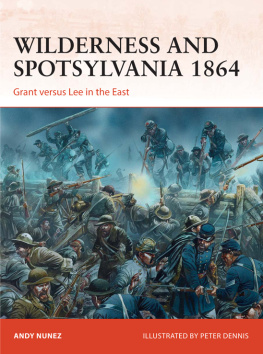Published by Louisiana State University Press
Copyright 2000 Louisiana State University Press
All rights reserved
Manufactured in the United States of America
Louisiana Paperback Edition, 2005
Second printing, 2010
Typeface: Cochin, Times Roman
Typesetter: Crane Composition
LIBRARY OF CONGRESS CATALOGING-IN-PUBLICATION DATA
Rhea, Gordon C.
To the North Anna River : Grant and Lee, May 1325, 1864 / Gordon C. Rhea.
p. cm.
Includes bibliographical references and index.
1. North Anna River (Va.), Battle of, 1864. 2. Grant, Ulysses S. (Ulysses Simpson), 18221885. 3. Lee, Robert, E. (Robert Edward), 18071870. 4. Wilderness, Battle of the, Va., 1864. 5. Spotsylvania Court House, Battle of, Va., 1864. 6. VirginiaHistoryCivil War, 18611865 Campaigns. 7. United StatesHistoryCivil War, 18611865Campaigns. I. Title.
E476.52.R478 2000
973.736dc21 99-050637
ISBN 978-0-8071-3111-4 (pbk.)
The paper in this book meets the guidelines for permanence and durability of the Committee on Production Guidelines for Book Longevity of the Council on Library Resources.

Acknowledgments
SURPRISINGLY LITTLE HAS been written about the campaign between Grant and Lee from May 13 through May 25, 1864. Confederate sources are scarce. Union sources, while more plentiful, are frequently vague and contradictory. Many diarists who penned stirring accounts of the Wilderness, Laurel Hill, and the Mule Shoe were dead, wounded, or in prison. Those still living were too exhausted to scribble more than cursory jottings. After the war, when veterans wrote their reminiscences, the marching and fighting from the Bloody Angle to Cold Harbor had blurred into indistinct memories. Historians attempting to reconstruct those momentous days face a daunting task. Jedediah Hotchkiss, the Confederate 2nd Corpss cartographer, tried to make sense of existing accounts and found himself wandering about in the entanglements of conflicting statements, at times well nigh lost and inclined to wash my hands of the whole matter, but am in for it and cannot escape. Time has not eased the undertaking.
Few historians have explored this phase of Grants and Lees evolving generalship. I have been honored to know two brave souls who strode where others feared to tread. William D. Matters If It Takes All Summer: The Battle of Spotsylvania (Chapel Hill, 1989), remains the best single recounting of Grants and Lees last days at Spotsylvania Court House. Mr. Matter and I have often walked Spotsylvanias fields together, and I was delighted when he reviewed my manuscript. By the same token, J. Michael Miller, author of The North Anna Campaign: Even to Hell Itself (Lynchburg, Va., 1989), is the foremost student of Grants and Lees maneuvers through Caroline County. Mr. Miller played an important part in establishing the North Anna Battlefield Park, preserving for posterity the spectacular left wing of Lees inverted V formation. He, too, made time in his busy schedule to visit sites with me and to review my manuscript. This book would be considerably diminished without the help of those two exceptional scholars.
The most important sources for reconstructing the battles are the fields themselves. Much ground involved in the operations from May 1320 lies within the Fredericksburg and Spotsylvania National Military Park. I am grateful to Robert K. Krick, chief historian of the park, and to the outstanding staff historians who work there, including Noel G. Harrison, John J. Hennessy, Gregory A. Mertz, Francis A. OReilly, Donald C. Pfanz, and Mac Wyckoff. They gave willingly of their time, exploring remote sites with me, guiding me to sources, and reviewing my manuscript. I am also indebted to the parks seasonal historian Eric J. Mink, now a full-time historian at the Richmond National Battlefield Park. The Ox Ford battlefield lies within the North Anna Battlefield Park. I thank Len Riedel and the Blue and Gray Education Society for supplying me copies of signs and maps the society installed at the park.
Many sites are privately owned. Owners graciously showed me their property and shared letters, newspaper clippings, and family stories. I am deeply indebted to Agnes V. McGee, who gave me free rein to wander the Harris farm; Raymond Bruce, Virginia Bruce, and their friend John Robert Davidson, who provided me coffee and a tour of the Catlett house and yard; Mrs. Vernon Lucy, who showed me the Motley house and let me sit on the porch where Grant singed Mr. Motleys furniture; Carroll Hayden, who showed me around Stirling Plantation, on Guinea Station Road; Michele Schiesser, for her hospitality at La Vista Plantation, on Guinea Station Road; Joyce Ackerman, of Roxbury Mills, who permitted me to explore the earthworks at Stanards Mill; Cameron Wood, for permission to explore Henagans redoubt; and Jeffrey McKinney, who turned me loose on the Jericho Mills battlefield site. Special thanks is due Ray S. Campbell Jr., clerk of Caroline County. Mr. Campbell, whose forebears rode in the 9th Virginia Cavalry, helped locate long-forgotten landmarks and supplied me with maps, surveys, and deeds.
Bryce A. Suderow, researcher extraordinary, assisted immeasurably in my quest for Civil Warera newspapers and gave insightful comments about my manuscript. Historians and buffs across the country guided me to obscure sources. Among those who helped were Tom Asselta, Edwin W. Besch, Daniel J. Beattie, Keith S. Bohannon, B. Conrad Bush, Mary Bandy Daughtry, David M. Guest, Theodore C. Mahr, Scott C. Patchen, Robert G. Poirier, Michael T. Russert, Robert J. Trout, Noah Andre Trudeau, Zack C. Waters, and Eric J. Wittenberg. I am also grateful to archivists and librarians for the institutions listed in the bibliography, and to Alfred C. Young, who helped me determine Confederate losses.
Robert E. L. Krick of the Richmond National Battlefield Park gave invaluable suggestions on the chapters covering cavalry operations. David D. Finney Jr., of Howell, Michigan, assisted with Michigan material and read much of the manuscript. Keith Poulter published modified versions of chapters II and VI as articles in North & South magazine and offered valuable editorial advice. I extend sincere thanks to Michael T. Snyder, of Pottstown, Pennsylvania, who gave my entire manuscript a careful reading, and to Patrick S. Brady of Seattle, Washington, who applied his red pen to the entire manuscript. Mr. Brady is completing a superb recounting of the Cold Harbor operations, and his comments were especially helpful.
George F. Skoch prepared maps for this volume, as he did for my previous two books, proving once again that a picture is worth a thousand words. Gerry Anders and Elizabeth Simon deftly wielded their editorial pens to my considerable advantage. I owe more than I can express to my wife Catherine, who patiently shared with me the trials attendant to a project of this magnitude, and to our two sons, Campbell and Carter. They have become eager participants in their parents quest to understand the past and build a brighter future.


